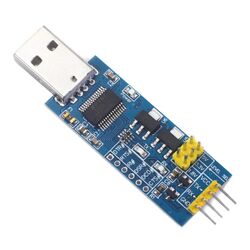FT232RL
Jump to navigation
Jump to search
FT232RL USB-to-Serial Adapter
The FT232RL is a high-performance USB-to-UART bridge developed by FTDI (Future Technology Devices International). Commonly known for its reliability and feature-rich design, it facilitates serial communication between USB-equipped hosts and TTL-level devices such as microcontrollers, FPGAs, and development boards.
Overview
- 💡 **Integrated Features**: The FT232RL combines a USB 2.0 full-speed controller, UART interface, internal oscillator, and EEPROM into a single chip.
- 🔌 **Versatile Voltage Support**: Operates with I/O voltages ranging from 1.8V to 5V, ensuring compatibility with a wide array of logic levels.
- 📈 **High Data Throughput**: Supports baud rates up to 3 Mbps, catering to high-speed serial communication needs.
- 🧰 **Driver Support**: Offers native drivers for Windows, macOS, and Linux, simplifying integration across platforms.
FT232RL Breakout Module
Breakout boards featuring the FT232RL chip provide easy access to its functionalities, making them popular for prototyping and development purposes.
Pin Configuration
| Pin Label | Function | Notes |
|---|---|---|
| GND | Ground | Common reference point; connect first |
| TXD | Transmit Data | Serial output from adapter (connect to target RX) |
| RXD | Receive Data | Serial input to adapter (connect to target TX) |
| VCC | Module Power Supply | Typically connected to 5V USB power |
| VCCIO | I/O Voltage Reference | Determines logic level for TXD/RXD; connect to 3.3V or 5V as needed |
| 3V3OUT | 3.3V Output | Provides up to 50 mA; useful for powering low-current 3.3V devices |
| DTR | Data Terminal Ready | Used for auto-reset in programming microcontrollers |
| CTS | Clear to Send | Hardware flow control input |
| RTS | Request to Send | Hardware flow control output |
Voltage Configuration Tips
- **Logic Level Selection**: The VCCIO pin sets the logic level for UART signals. Connect it to 3.3V for 3.3V logic devices or to 5V for 5V logic devices.
- **Powering the Module**: The module is typically powered via the VCC pin connected to the USB's 5V supply. Ensure that the target device's voltage requirements align with the module's output.
- **3.3V Output Usage**: The 3V3OUT pin provides a regulated 3.3V output, suitable for powering low-current devices. Do not use it to power the entire system.
Wiring Instructions
- **Ground Connection**: Always connect the GND pin first to establish a common ground between the adapter and the target device.
- **Serial Connections**: Cross-connect the serial lines—adapter's TXD to target's RXD, and adapter's RXD to target's TXD.
- **Voltage Matching**: Ensure that the logic levels of the adapter and the target device are compatible. Use level shifters if necessary.
- **Flow Control**: If not using hardware flow control, leave the CTS and RTS pins unconnected or configure them appropriately in software.
Applications
- **Microcontroller Programming**: Commonly used for programming Arduino, ESP8266, STM32, and other microcontrollers via UART.
- **Serial Debugging**: Facilitates serial communication for debugging embedded systems.
- **Firmware Updates**: Enables firmware flashing on devices that support UART-based updates.
- **Data Logging**: Useful in applications requiring serial data logging to a PC.
